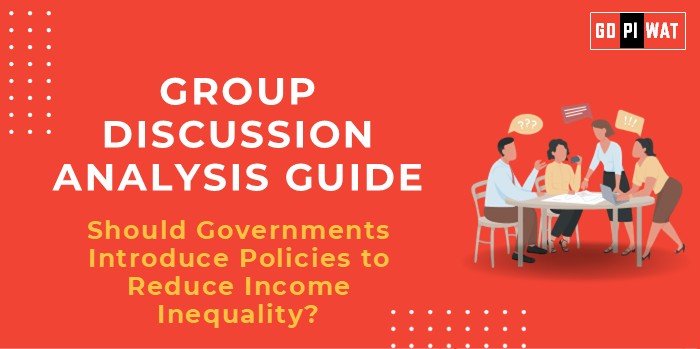📋 Group Discussion (GD) Analysis Guide: Should Governments Introduce Policies to Reduce Income Inequality?
🌐 Introduction
Opening Context: Income inequality remains a pressing issue globally, as disparities in wealth continue to widen, impacting economic stability and social harmony.
Topic Background: Historical patterns and recent trends show that income concentration among the wealthiest segments often exacerbates poverty and limits economic mobility. Governments are exploring redistributive policies as a means to address this imbalance while fostering inclusive growth.
📊 Quick Facts & Key Statistics
- 🌍 Global Wealth Distribution: As of 2023, the top 1% of the world’s population holds approximately 34% of global wealth.
- 🇮🇳 India’s Inequality: The top 1% of earners in India account for 22.6% of the country’s national income, exceeding levels during British colonial rule.
- 📈 Policy Potential: A progressive tax of 2% on assets over $1 billion could generate significant revenue to address inequality.
- 📉 Economic Growth Impact: High inequality restricts educational and economic opportunities, reducing overall productivity and hindering economic growth.
🤝 Stakeholders and Their Roles
- 🏛️ Government: Introduces redistributive policies like progressive taxation and public welfare programs.
- 💼 Private Sector: Adopts fair pay practices and supports philanthropic efforts to bridge income gaps.
- 📢 Civil Society Organizations: Advocates for equitable reforms and monitors policy implementation.
- 🌐 International Institutions: Offers funding and expertise for poverty alleviation programs.
📚 Achievements and Challenges
🏆 Achievements
- ✅ Progressive Taxation Examples: Nordic countries have successfully reduced inequality through high taxes on wealth.
- 💵 Social Investments: Programs like Brazil’s Bolsa Família have demonstrated how direct cash transfers improve livelihoods.
- 🌍 Global Revenue Potential: Taxing billionaire assets could generate funds to alleviate extreme poverty.
⚠️ Challenges
- 🔒 Policy Resistance: Opposition from influential elites often delays wealth redistribution policies.
- 📉 Global Comparisons: In India, income inequality surpasses colonial-era levels, underscoring implementation gaps compared to countries like Sweden or Denmark.
- ⚖️ Economic Trade-offs: Over-regulation may deter investment and innovation.
💡 Effective Discussion Approaches
📜 Opening Approaches
- 📊 Statistical Insight: “With the top 1% holding 34% of global wealth, reducing inequality is critical to fostering inclusive growth.”
- 🇮🇳 Case Study-Based: “India’s income disparity, surpassing colonial-era levels, highlights the urgency for corrective policy measures.”
🔄 Counter-Argument Handling
- ⚖️ Example: “Redistribution policies may disincentivize investment.” Response: “Redistribution can coexist with growth by funding education and infrastructure, which ultimately benefits investors.”
📊 Strategic Analysis of Strengths & Weaknesses
- 🌟 Strengths:
- Promotes social stability.
- Expands economic opportunities.
- ⚠️ Weaknesses:
- Implementation challenges.
- Potential investor reluctance.
- ✨ Opportunities:
- Use progressive taxes to fund skill development programs.
- ⚡ Threats:
- Political opposition and policy backlash.
🗣️ Structured Arguments for Discussion
- 👍 Supporting Stance: “Reducing income inequality enhances economic growth by providing wider access to education and opportunities.”
- 👎 Opposing Stance: “Over-regulation might harm economic freedom and innovation.”
- ⚖️ Balanced Perspective: “Policies must ensure redistribution without stifling entrepreneurial incentives.”
🎓 Connecting with B-School Applications
- 📘 Real-World Applications:
- Inequality reduction strategies provide case studies for CSR initiatives, policy analysis, and financial inclusion projects.
- ❓ Sample Interview Questions:
- “How can progressive taxation be balanced to encourage both equity and growth?”
- “What role can private enterprises play in reducing income inequality?”
- 📖 Insights for Students:
- Analyze public-private partnership models that promote equitable resource distribution.


